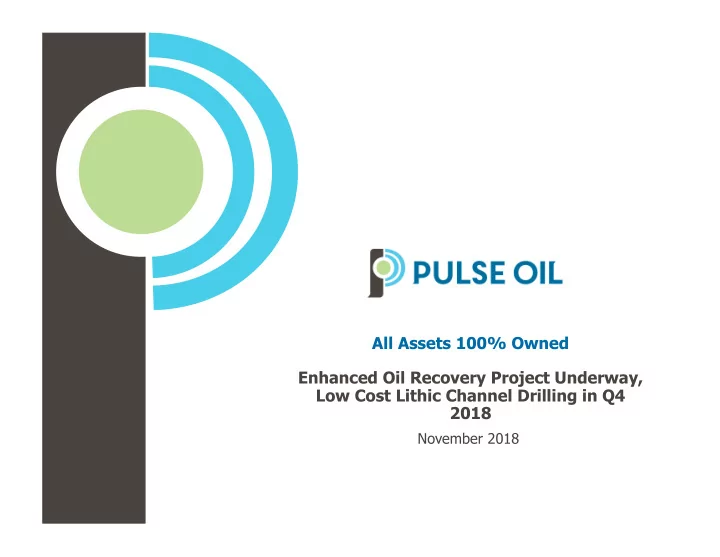

All Assets 100% Owned Enhanced Oil Recovery Project Underway, Low Cost Lithic Channel Drilling in Q4 2018 November 2018
Disclaimers This document is for information purposes only and is not an offer to sell, nor a solicitation of an offer to purchase, any securities. It does not purport to contain all of the information that a prospective investor may require and is not intended to provide any legal, tax, or investment advice. BOE’s: Pulse Oil Corp. (“Pulse” or the “Company”) has adopted the standard of six thousand cubic feet of gas to equal one barrel of oil when converting natural gas to “BOEs.” BOEs may be misleading, particularly if used in isolation. A BOE conversion ratio of 6Mcf: 1 Bbl is based on an energy equivalency conversion method primarily applicable at the burner tip and does not represent a value equivalency at the wellhead. All oil and natural gas reserves and resources information, including estimated production rates and estimated future net revenue, contained in this presentation have, unless otherwise stated, been prepared and presented in accordance with National Instrument 51-101 -Standards of Disclosure for Oil and Gas Activities ("NI 51-101") and the Canadian Oil and Gas Evaluation ("COGE") Handbook. Reserves Estimates: Reserves are estimated remaining quantities of oil and natural gas and related substances anticipated to be recoverable from known accumulations, as of a given date, based on analysis of drilling, geological, geophysical and engineering data, the use of established technology, and specified economic conditions, which are generally accepted as being reasonable, and shall be disclosed. Reserves are classified according to the degree of certainty associated with the estimates. Proved reserves are those reserves that can be estimated with a high degree of certainty to be recoverable. It is likely that the actual remaining quantities recovered will exceed the estimated proved reserves. Probable reserves are those additional reserves that are less certain to be recovered than proved reserves. It is equally likely that the actual remaining quantities recovered will be greater or less than the sum of the estimated proved plus probable reserves. Possible reserves are those additional reserves that are less certain to be recovered than probable reserves. It is unlikely that the actual remaining quantities recovered will exceed the sum of the estimated proved plus probable plus possible reserves. The qualitative certainty levels referred to in the definitions above are applicable to "individual reserves entities", which refers to the lowest level at which reserves calculations are performed, and to "reported reserves", which refers to the highest level sum of individual entity estimates for which reserves estimates are presented. Reported reserves should target the following levels of certainty under a specific set of economic conditions: • at least a 90 percent probability that the quantities actually recovered will equal or exceed the estimated proved reserves; • at least a 50 percent probability that the quantities actually recovered will equal or exceed the sum of the estimated proved plus probable reserves; and • at least a 10 percent probability that the quantities actually recovered will equal or exceed the sum of the estimated proved plus probable plus possible reserves. The reserve estimates contained herein are estimates only and there is no guarantee that the estimated reserves or resources will be recovered. The estimates of reserves for individual properties may not reflect the same confidence level as estimates of reserves for all properties, due to the effects of aggregation. Where discussed herein "NPV10%“ or “NPV10” represents the net present value (net of capital expenditures) of net income discounted at 10%, with net income reflecting the indicated oil, liquids and natural gas prices and initial production rate, less internal estimates of operating costs and royalties. It should not be assumed that the future net revenues estimated by Pulse’s independent reserve evaluators represent the fair market value of the reserves, nor should it be assumed that Pulse’s internally estimated value of its undeveloped land holdings or any estimates referred to herein from third parties represent the fair market value of the lands. Resource Estimates: The oil and natural gas resource estimates in this document were prepared for Pulse and unless otherwise noted, the resource estimates in this presentation are a prepared by Pulse’s independent and qualified reserves evaluator in accordance with NI 51-101 and the COGE Handbook, with an effective date of December 6, 2017. Contingent Resource volumes for these discovered resources have been classified as 'development unclarified' with Sproule assessing that there is a high probability of the Bigoray EOR project becoming a commercial development. Pulse will continue to complete project planning associated with the project and move forward with its execution plans in 2018. Sproule estimated there being a 77% chance of development taking place (23% chance of development not taking place). Significant positive factors relevant to the estimate of Pulse’s contingent resources from the Bigoray EOR project include success of miscible flood development in nearby analogous Nisku reservoirs, a discovered thick oil column providing volumes for the deployment of enhanced oil recovery through a miscible flood Proven production in close proximity; current production from waterflood in Pulse 100% owned Bigoray assets ; 3D seismic coverage across permits and a nearby infrastructure allowing for access to market. Significant negative factors relevant to the estimate of Pulse’s contingent resources from the Bigoray EOR project include uncertainty to how the previously fully waterflooded pools will respond to a miscible flood, costs may be more to conduct EOR program than estimated, forecasted production rates may be incorrect, economic viability uncertainty, as project capital and operating costs are unclear; and there may be areal uncertainties in the estimation of PIIP. 2
Recommend
More recommend